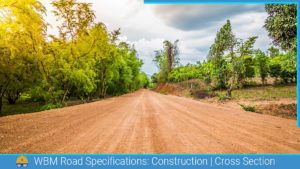Road Camber refers to the slight slope or curve intentionally designed into a road surface in the transverse direction to facilitate efficient drainage of rainwater and help the diver handle the vehicle efficiently. It is also known as a cross slope or road crown. The road is constructed with a gentle transverse slope, which means it is higher in the middle and lower on the edges.
The Objective Camber
Road camber is a vital component in both the design and maintenance of roads, prioritizing the safety of commuters. To achieve this, camber is implemented on straight roads by elevating the centre of the carriageway in relation to the edges, creating a crown or the highest point along the centerline. The objective of providing a chamber is as follows:
- Surface Protection: Road camber plays a vital role in protecting the surface of the road, particularly for gravel and bituminous roads. The sloping design of the road allows water to drain efficiently, preventing water accumulation on the surface. This helps to minimize the risks of surface erosion, pothole formation, and degradation caused by water damage. By facilitating proper drainage, road camber extends the lifespan of the road surface and reduces the need for frequent repairs or resurfacing.
- Subgrade Protection: Proper drainage is essential for protecting the subgrade, which is the natural soil or prepared foundation layer beneath the road. When water is allowed to accumulate on the road surface, it can seep into the subgrade, leading to soil saturation, reduced load-bearing capacity, and potentially causing the road to fail. Road camber helps in effectively draining rainwater away from the road, preventing water from infiltrating and damaging the subgrade. By maintaining a dry subgrade, the overall stability and durability of the road structure are preserved.
- Quick Drying of Pavement and Increased Safety: Road camber promotes the quick drying of the pavement after rainfall or wet conditions. The slope of the road allows rainwater to flow rapidly towards the edges, preventing water from pooling on the surface. As a result, the road surface dries faster, reducing the risk of hydroplaning and improving vehicle traction. Faster drying also enhances visibility, minimizing the potential for accidents caused by reduced visibility in wet conditions. Consequently, road camber contributes to increased safety for drivers by maintaining dry and safe driving conditions.
Requirement of Camber
The requirement of camber for pavement depends on:
- The type of pavement surface
- The amount of rainfall
Types of road Camber
The common types of camber are parabolic, straight or a combination of both.
Parabolic Camber
Parabolic camber refers to a curved road surface that follows a parabolic shape. The centre of the road is the highest point, and the slope decreases gradually towards the edges. This type of camber is often used on roads with moderate speeds and curvatures.

Straight Camber
In this type, the road surface has a consistent slope from one edge to the other. The centre of the road is elevated, and the slope gradually decreases towards the edges. Straight camber is typically employed on roads with lower speeds and less curvature.

Composite Camber
Composite camber is also referred to as compound camber due to the combination of both parabolic and straight camber present in the road cross-section design. The road surface has a parabolic curve at the centre portion, while the sides follow a straight slope. This type of camber is typically employed on roads with higher speeds and curvatures.

Cross Slop in the field
To achieve the intended amount and shape of the camber, camber board templates are created with the specified curvature. These templates serve the purpose of verifying the lateral profile of the completed pavement during construction. The type of camber board prepared depends on the chosen camber shape. Creating a straight-line camber is a straightforward process. However, when dealing with a parabolic camber, a general equation can be utilized as follows.

“a” for a pavement width W and cross slop of 1 in n.
Advantages of Camber
The advantages of benefits of having camber are as explained below:
Drainage system: Camber facilitates efficient drainage of rainwater, effectively safeguarding the foundation course of the road structure from weakening caused by water infiltration through the road surface. This helps to preserve the integrity of the road’s foundation course by preventing the detrimental effects of rainwater percolation.
Improve Vehicle Menoeuvore: One of the advantages of having a camber on the road is to help improve vehicle manoeuvre and handling of the vehicle by the diver.
Increased Safety: Incorporating appropriate camber into a road design enhances its overall safety. A straight Camber plays a crucial role in mitigating the risk of oversteering, which can be highly dangerous, particularly on high-speed highways. Furthermore, it helps diminish the impact of lateral winds, leading to enhanced stability when driving in windy conditions. Thus, a road with proper camber contributes to improved safety measures.
Method of Providing Camber
The method of providing camber in road design involves raising the centerline of the road with respect to the edges, creating a slight slope or curvature. This is done to ensure proper drainage and enhance the safety and stability of the road. Here are the steps involved in providing camber:
- Determine the desired camber: The appropriate amount of camber depends on various factors such as road type, anticipated traffic volume, and design speed. Guidelines and standards provided by road authorities are typically followed to determine the suitable camber for a particular road.
- Establish the centerline: The centerline of the road is marked or established based on the road alignment design. This serves as the reference point for implementing the camber.
- Determine the road edge levels: The levels of the road edges are determined based on the road cross-section design. This includes factors like pavement thickness, pavement layers, and the desired road width.
- Calculate the camber slope: The camber slope is calculated based on the road width and the desired camber. It is usually expressed as a percentage or a ratio, indicating the rise in elevation per unit of horizontal distance.
- Construct the road surface: During road construction, the centerline is raised with respect to the edges to achieve the desired camber slope. This can be achieved by adjusting the thickness of the pavement layers or incorporating additional materials.
- Verify the camber: Once the road surface is constructed, it is important to verify the camber to ensure it meets the design specifications. Surveying instruments such as levels or laser technology can be used to measure the actual camber slope.
IRC value for Camber
| Surface | Heavy Rain | Light Rain |
|---|---|---|
| Earthen | 4% | 2.5% |
| Gravel/WBM | 3% | 2.5% |
| Concrete/Bituminous | 2% | 1.7% |
Maintenance of Road Camber
Maintaining the correct road camber is essential for safe and efficient driving. Regular inspections should be conducted to ensure a smooth and defect-free road surface. Any excessive slope or tilt must be promptly addressed to prevent accidents. Timely repairs should be carried out using appropriate materials and following guidelines. Worn-out parts should be replaced to maintain balance and alignment. Choosing durable materials is crucial for consistent camber performance. Overall, regular maintenance and prompt action are necessary to uphold the desired road camber and ensure optimal driving conditions.
FAQs:
Q: What is camber?
Ans: Camber is an intentional design and creates a slight slope or curve on a road surface to enable effective drainage of rainwater and enhance vehicle control. The road is constructed with a gentle transverse slope, with the centre portion elevated and the edges slightly lower. It is also referred to as a road cross slope or road crown.
Q: Why camber is important in road design and construction?
Ans: Camber is important in road design and construction to serve the following functionality:
1. Surface protection by facilitating proper drainage to minimise the risks of surface erosion, pothole formation, and degradation caused by water damage.
2. Subgrade protection by effectively draining rainwater away from the road, preventing water from infiltrating and damaging the subgrade.
3. Quick drying of pavement and increased Safety for drivers by maintaining dry and safe driving conditions.
Q: What are the types of camber?
Ans: There are generally three types of camber namely Parabolic camber, Straight camber and Composite camber which includes both parabolic and straight camber.
Also, read:
- 12 Types of Cracks in asphalt pavement | How to repair
- What is Rigid Pavement? | 4 Types.
- Dowel Bar | Purpose | Usage | Advantages
![]()







